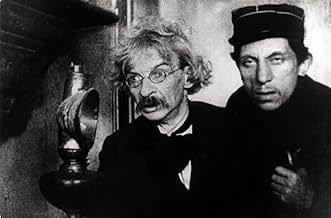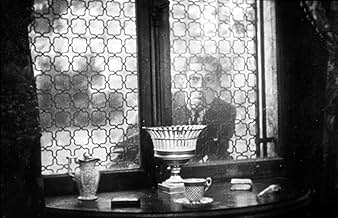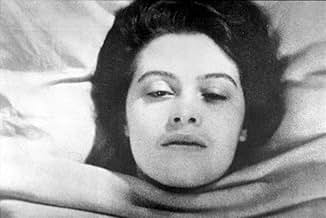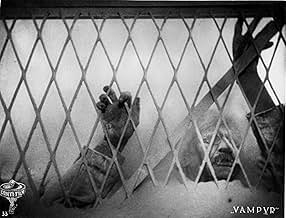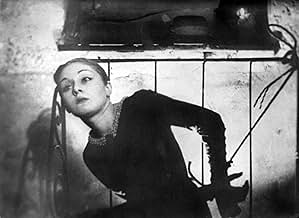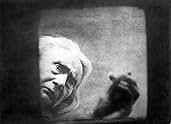IMDb-BEWERTUNG
7,4/10
21.810
IHRE BEWERTUNG
Ein vom Übernatürlichen besessener Vagabund stößt auf ein Gasthaus, in dem ein schwer krankes heranwachsendes Mädchen langsam zum Vampir wird.Ein vom Übernatürlichen besessener Vagabund stößt auf ein Gasthaus, in dem ein schwer krankes heranwachsendes Mädchen langsam zum Vampir wird.Ein vom Übernatürlichen besessener Vagabund stößt auf ein Gasthaus, in dem ein schwer krankes heranwachsendes Mädchen langsam zum Vampir wird.
- Regie
- Drehbuch
- Hauptbesetzung
- Auszeichnungen
- 1 wins total
Henriette Gérard
- Die alte Frau vom Friedhof (The Old Woman from the Cemetery)
- (as Henriette Gérard)
Kani Kipçak
- Michael
- (Nicht genannt)
Empfohlene Bewertungen
Another person said it best in a previous review, "Vampyr" is a masterpiece of suggested horror with truly frightening and disturbing scenes throughout. A warning in advance. This is an extremely slow moving picture. It seems to drag and usually that really bothers me but this movie is so full of images, it makes up for it. The movie is subtitled but it hardly matters since there is so little dialogue. The movies unfolds in a strange dream-like state and stays that way throughout. Your not really sure if it is day or night. There are many memorable scenes also. The policeman sitting in his chair moments before his shadow also sits down, the infamous dream burial sequence induced by a blood transfusion and so many more! If you like wonderful images and camerawork as well as a few chills, this film is for you! Highly recommended!
"Vampyr", one of the first horror movies with sound, is the work of the highly influential danish director Carl Theodor Dreyer. After directing the monumental "La Passion de Jeanne d'Arc" in 1928, Dreyer decided to make this modest film based on the novel "In a Glass Darkly" by Sheridan Le Fanu; while this is indeed his first movie with sound, it was conceived as a silent film, and the movie contains very few dialog.
I must admit that as many, I was left with a big question mark in my face as the story was progressing; but the apparently disjointed storyline do make sense, as it is worked as a surreal experience of the lead character, it is as if Dreyer had filmed a nightmare, complete with the haunting images and eerie atmosphere.
The movie is about a traveler, named Allan Grey (Julian West), who gets involved in a nightmarish plot when the owner of the inn where he is staying asks him for help to save his family from what he believes is a vampire. We follow Allan Grey in his surrealistic trip to madness as he finds out more and more about the supposed vampire that haunts the manor turned inn.
The highly inventive camera work is truly outstanding, the combination of light and darkness is among the finest work in a black & white film and alone makes the movie worth a look; the movie not only has the structure of a nightmare, it also looks like one. The Gothic manor and the lonely rural exteriors increase the haunting atmosphere and the beautiful images Dreyer conceived are the work of a genius.
The structure of the script may be complicated, but it shows its influence over David Lynch and other filmmakers with similar surrealist story lines and dreamlike sequences. It is probably not a masterpiece of the likes of the aforementioned "Passion" or the more well-known "Day of Wrath" (Vredens dag, 1943), but "Vampyr" shines with its own light as one of the finest horror movies of that period.
The only real flaw in my opinion, was that the lead actor, Julian West, was probably not the best choice for a lead role, as his acting seems unnatural and not believable. I'm not sure if this was intended that way or had more to do with the fact that West produced the film, but it is my only complain about "Vampyr".
This modest masterpiece is a must see for any horror fan or anyone who likes silent movies. It is a nightmarish trip to the darker parts of the subconscious mind. 8/10
I must admit that as many, I was left with a big question mark in my face as the story was progressing; but the apparently disjointed storyline do make sense, as it is worked as a surreal experience of the lead character, it is as if Dreyer had filmed a nightmare, complete with the haunting images and eerie atmosphere.
The movie is about a traveler, named Allan Grey (Julian West), who gets involved in a nightmarish plot when the owner of the inn where he is staying asks him for help to save his family from what he believes is a vampire. We follow Allan Grey in his surrealistic trip to madness as he finds out more and more about the supposed vampire that haunts the manor turned inn.
The highly inventive camera work is truly outstanding, the combination of light and darkness is among the finest work in a black & white film and alone makes the movie worth a look; the movie not only has the structure of a nightmare, it also looks like one. The Gothic manor and the lonely rural exteriors increase the haunting atmosphere and the beautiful images Dreyer conceived are the work of a genius.
The structure of the script may be complicated, but it shows its influence over David Lynch and other filmmakers with similar surrealist story lines and dreamlike sequences. It is probably not a masterpiece of the likes of the aforementioned "Passion" or the more well-known "Day of Wrath" (Vredens dag, 1943), but "Vampyr" shines with its own light as one of the finest horror movies of that period.
The only real flaw in my opinion, was that the lead actor, Julian West, was probably not the best choice for a lead role, as his acting seems unnatural and not believable. I'm not sure if this was intended that way or had more to do with the fact that West produced the film, but it is my only complain about "Vampyr".
This modest masterpiece is a must see for any horror fan or anyone who likes silent movies. It is a nightmarish trip to the darker parts of the subconscious mind. 8/10
For a movie made in 1932, this is very, very impressive. Confusing plot aside, the emphasis in this Victorian nightmare is placed on the cinematic aspects. "Vampyr" is plodding, very dark and eerie, filled with such haunting atmosphere and brooding visuals full of unseen, but lurking terror - very effecting. It works on a subconscious and emotional level more than any other way. I think it's worth a look.
Since I was a kid interested in foreign and older films, I've been haunted by this picture. I remember seeing a shot of the back of a woman's head. She slowly turns around to reveal black lips, darkened eyes, and a smile of someone possessed of the vampire spirit.
Later, in school, I had the pleasure of seeing more of Dreyer's work. He didn't make any more 'horror pictures' to my knowledge, but everything else I saw had the same brooding, eerie sense, the same lack of interest in a driving plot, and the same photographic expertise that kept me enthralled when I first saw this picture.
He's considered one of the masters. He's not to everyone's taste. But, with VAMPYR, he got to me before I ever learned how to say the word 'cinema.'
Later, in school, I had the pleasure of seeing more of Dreyer's work. He didn't make any more 'horror pictures' to my knowledge, but everything else I saw had the same brooding, eerie sense, the same lack of interest in a driving plot, and the same photographic expertise that kept me enthralled when I first saw this picture.
He's considered one of the masters. He's not to everyone's taste. But, with VAMPYR, he got to me before I ever learned how to say the word 'cinema.'
Too often horror films are thought of as light-weight entertainment. Even the best are under-appreciated for what they can tell us about human nature. In the case of Carl Dreyer's "Vampyr," however, all you seem to hear is high-brow rhetoric about how the film's dream-like illogic makes it a meditation upon death. For just once forget all the intellectual mumbo-jumbo and watch this film for what it is, one creepy little flick and the pioneering vampire film of the '30s. It was in production a year before "Dracula" but released the year after, and is a better and scarier film, unless bats on strings scare you.
It's not a silent movie but feels like one - an exceptionally fine one. So if you are put off by non-talking films be warned, dialog is spare, cut to the bone; but the musical score is very good and sinister. The main attractions are the images: shadows that kill people, a spirit that leaves its body, a corpse-eye view of a burial, and other uncanny occurrences that lead young Allan Grey to a girl suffering from a mysterious illness, and to her doctor, a vampire's accomplice who supplies his crone-like patroness with fresh victims.
Possibly the film's poor reception by critics and audiences was because the 1930 soundtrack was too primitive to be appreciated by viewers in 1932, who by then were used to lots of chatter - and because the earlier release of "Dracula" blunted its impact. But with little dialog and without the stagnating influence of a stationary microphone our eyes feast on Hermann Warm's eerie art direction, and are guided by Rudolph Mate's camera, which keeps us off balance, misdirecting our point of view as when it pans to a door through which a nurse exits her patient's room, then pans back again to reveal an empty bed just before the victim's sleep-walking rendezvous with the vampire.
The film bears even less resemblance to its source (Sheridan Le Fanu's "Carmilla") than "Dracula" does to Stoker's novel, possibly because it borrows from another story, Mary Elizabeth Braddon's "Good Lady Ducayne," in which a young man comes to the aid of a young paid female companion of an extremely aged woman whose doctor draws the young woman's blood for his patient to consume. And if "Vampyr's" plot often seems incoherent, so does "Dracula's." The performances, however, are vastly superior. Sybille Schmitz in particular, as the vampire's victim, conveys with her subtle expressions emotions for which spoken language is inadequate.
For those who already know this film, Martin Koerber's restoration on the Criterion release eliminates the large, black-bordered, Gothic subtitles, and corrects the too-bright day-for-night scenes that were so distracting on the Image disc. For others seeing "Vampyr" for the first time, relax, don't think too much, and enjoy!
It's not a silent movie but feels like one - an exceptionally fine one. So if you are put off by non-talking films be warned, dialog is spare, cut to the bone; but the musical score is very good and sinister. The main attractions are the images: shadows that kill people, a spirit that leaves its body, a corpse-eye view of a burial, and other uncanny occurrences that lead young Allan Grey to a girl suffering from a mysterious illness, and to her doctor, a vampire's accomplice who supplies his crone-like patroness with fresh victims.
Possibly the film's poor reception by critics and audiences was because the 1930 soundtrack was too primitive to be appreciated by viewers in 1932, who by then were used to lots of chatter - and because the earlier release of "Dracula" blunted its impact. But with little dialog and without the stagnating influence of a stationary microphone our eyes feast on Hermann Warm's eerie art direction, and are guided by Rudolph Mate's camera, which keeps us off balance, misdirecting our point of view as when it pans to a door through which a nurse exits her patient's room, then pans back again to reveal an empty bed just before the victim's sleep-walking rendezvous with the vampire.
The film bears even less resemblance to its source (Sheridan Le Fanu's "Carmilla") than "Dracula" does to Stoker's novel, possibly because it borrows from another story, Mary Elizabeth Braddon's "Good Lady Ducayne," in which a young man comes to the aid of a young paid female companion of an extremely aged woman whose doctor draws the young woman's blood for his patient to consume. And if "Vampyr's" plot often seems incoherent, so does "Dracula's." The performances, however, are vastly superior. Sybille Schmitz in particular, as the vampire's victim, conveys with her subtle expressions emotions for which spoken language is inadequate.
For those who already know this film, Martin Koerber's restoration on the Criterion release eliminates the large, black-bordered, Gothic subtitles, and corrects the too-bright day-for-night scenes that were so distracting on the Image disc. For others seeing "Vampyr" for the first time, relax, don't think too much, and enjoy!
Wusstest du schon
- WissenswertesFor much of the cast, this was their only film appearance, since they were not professional actors. Henriette Gérard, who played the vampire, was a French widow, Jan Hieronimko, who played the village doctor, was a Polish journalist, and Rena Mandel, who played Gisèle, was an artist's model. Julian West (real name: Baron Nicolas de Gunzburg), who played Allan Grey, was a French-born member of Russian nobility who agreed to finance the film in exchange for the leading part. (He later emigrated to America where he became a powerful fashion journalist and mentor to designers like Calvin Klein.)
- PatzerAt exactly 16 minutes (in the Criterion DVD) as the camera pans right, there is a reflection in a glass window of the camera operator cranking the camera.
- Alternative VersionenThere is an Italian edition of this film on DVD, distributed by DNA srl, "LA STRANA AVVENTURA DI DAVID GRAY (Vampyr - Il vampiro, 1932) + NOSFERATU, UNA SINFONIA DELL'ORRORE (1922)" (2 Films on a single DVD), re-edited with the contribution of film historian Riccardo Cusin. This version is also available for streaming on some platforms.
- VerbindungenEdited into Dr. Terror's House of Horrors (1943)
Top-Auswahl
Melde dich zum Bewerten an und greife auf die Watchlist für personalisierte Empfehlungen zu.
- How long is Vampyr?Powered by Alexa
Details
- Erscheinungsdatum
- Herkunftsländer
- Sprachen
- Auch bekannt als
- Vampyr - Der Traum des Allan Grey
- Drehorte
- Abbaye de Braye, Braye, Aisne, Frankreich(recreated cemetery)
- Produktionsfirma
- Weitere beteiligte Unternehmen bei IMDbPro anzeigen
- Laufzeit1 Stunde 15 Minuten
- Farbe
- Seitenverhältnis
- 1.19 : 1
Zu dieser Seite beitragen
Bearbeitung vorschlagen oder fehlenden Inhalt hinzufügen





